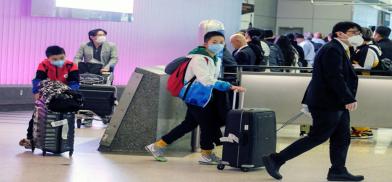Plan to evacuate Nepalis from abroad
The Nepalese government has released an 11-point action plan to bring back and manage citizens who have been affected by COV- ID-19 and want to return home

Kathmandu: The Nepalese government has released an 11-point action plan to bring back and manage citizens who have been affected by COV- ID-19 and want to return home.
Deputy Prime Minister Ishwor Pokharel, who is also coordinator of the High-Level Coordination Committee for the Prevention and Control of COV- ID-19, said the plan to evacuate Nepalis stranded abroad was approved yesterday. The committee had discussed the plan prepared by the technical taskforce assigned to do the needful on Friday.
As per the plan, the government has decided to deploy the Nepali Army as the number of infections started rising due to mismanagement of those returning from India. It has also designated 17 entry points for Nepalis returning from India and Tribhuvan International Airport for those flying from other countries.
Those who want to return will be evacuated on priority basis (see inset). However, they will have to furnish recent polymerase chain reaction and rapid diagnostic test check-up certificates before boarding the flight. Meanwhile, only 10 flights a day will be permitted to come to Nepal.
Though district administration and local levels are responsible for managing entry points at the Nepal-India border, the Nepali Army will also be deployed for immediate assistance.
The army will also be used to manage people who come from countries other than India.
The Ministry of Foreign Affairs and foreign missions abroad have been given the responsibility of identifying, prioritising, compiling and providing details of Nepali citizens coming from countries other than India. The MoFA has to furnish the details within 10 days.
As per the plan, returnee citizens will first be kept in a holding centre where the Nepali Army and health personnel will confirm their personal details.
District administration offices, local level and provincial governments and Nepali Army will be involved in managing evacuated citizens. The army, in coordination with provincial and local level governments, will manage transportation and drop people to their respective hometowns. However, those with body temperature of 100.4 degrees Fahrenheit or more will be immediately shifted to the isolation facility.
The holding centres will be selected, determined and managed province-wise before the evacuation process starts.
The high-level committee and local levels will manage the travel expenses of returnees after they check out from the holding centres.
The army will also manage quarantine facilities in coordination with local levels. However, quarantine facilities will have to be built by local levels.
In case of an emergency situation, the federal government will manage 300 isolation beds at Nepal Electricity Authority’s training office in Kharipati, 400 beds in Icchangunarayan Aawas area, 500 beds in Manmohan Hospital and 500 beds in KMC Hospital in Duwakot.
The plan also states that the Ministry of Labour, Employment and Social Security will be responsible for bringing back bodies of Nepalis who died abroad but could not be brought back due to suspension of international flights and hand them over to their families.
As per general practice, governments of the respective destinations or employer companies have to bear all the expenses of bringing back bodies to Nepal. However, if that is not possible then the Foreign Employment Promotion Board will do the needful.
The federal government will provide Rs 175 per day for 14 days of quarantine to the local levels for each person quarantined.
Expenses of holding centres will also be borne by the central government. However, returnees will have to pay for hotel expenses, air ticket and other travel expenses up to their quarantine.
The Ministry of Culture, Tourism and Civil Aviation will select and determine hotels for quarantine facility. The details of hotels will be posted on its website and work in this regard will start immediately.
As per the action plan, minister of physical Infrastructure and transport will be responsible for managing things for Province 1; minister of labour, employment and social security for Province 2; minister of women, children and senior citizens for Bagmati Province; minister of land management, cooperatives and poverty alleviation for Gandaki Province; minister of energy, water resources and irrigation for Province 5; minister of forests and environment for Karnali Province and minister of drinking water for Sudurpaschim Province.
https://thehimalayantimes.com/nepal/plan-to-evacuate-nepalis-from-abroad-unveiled/









Post a Comment